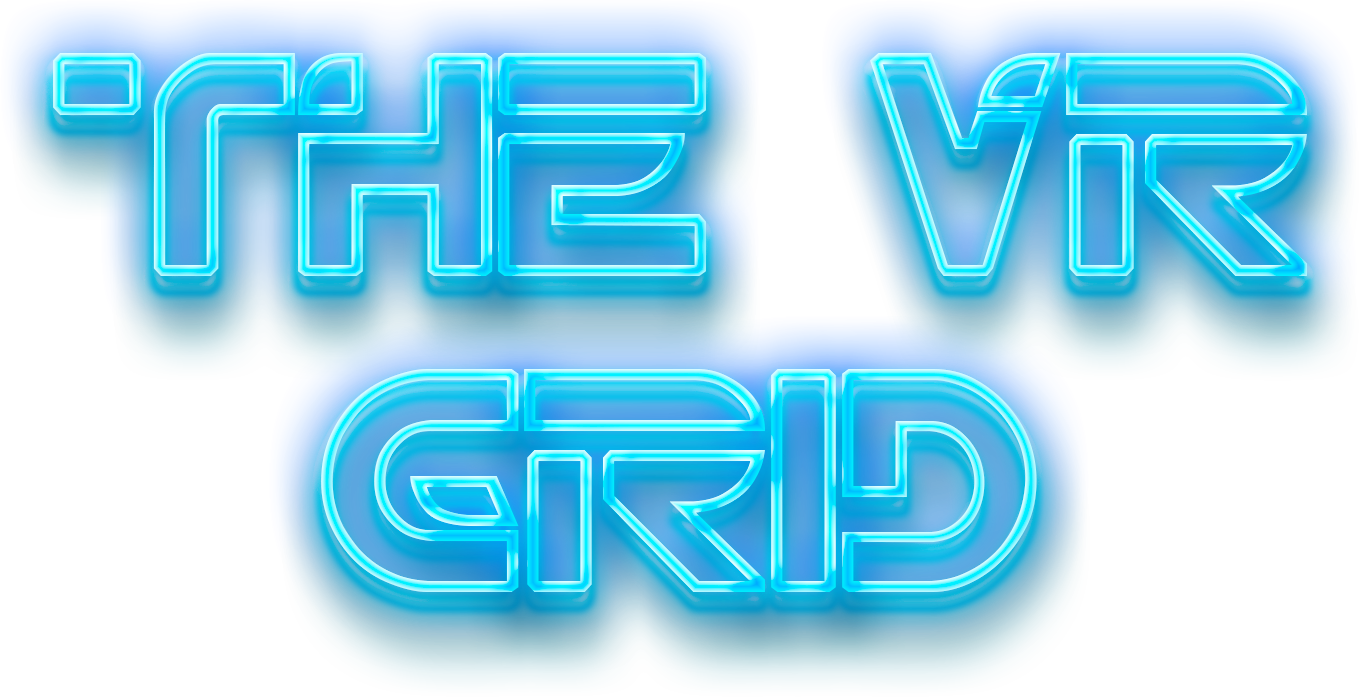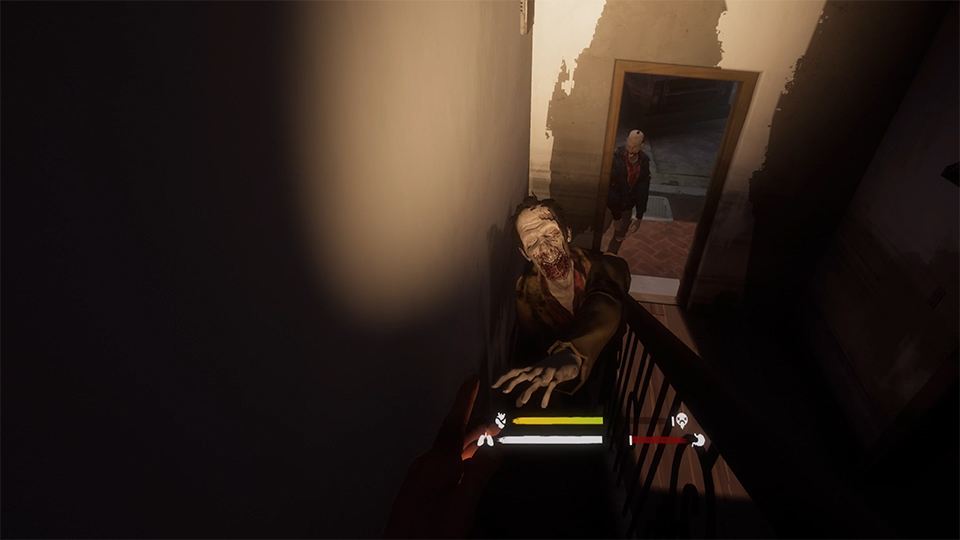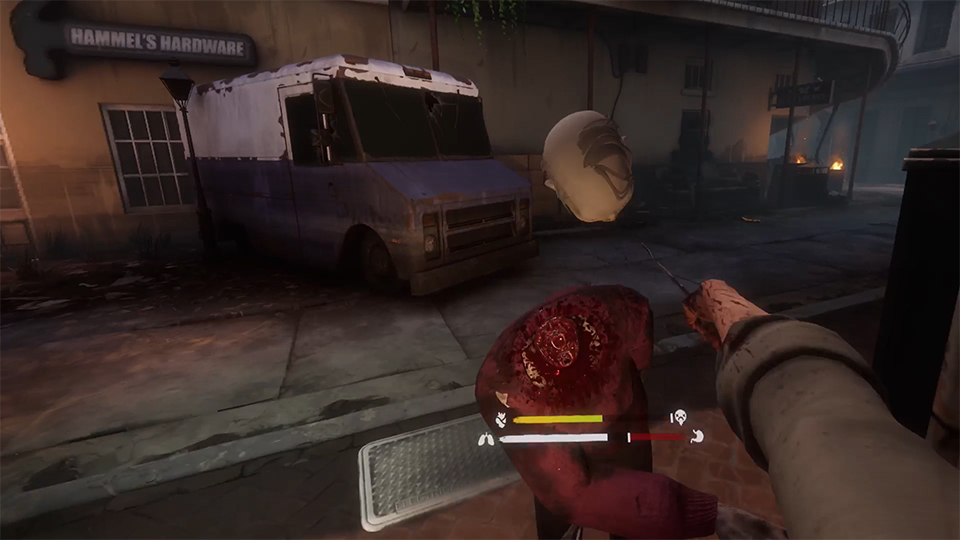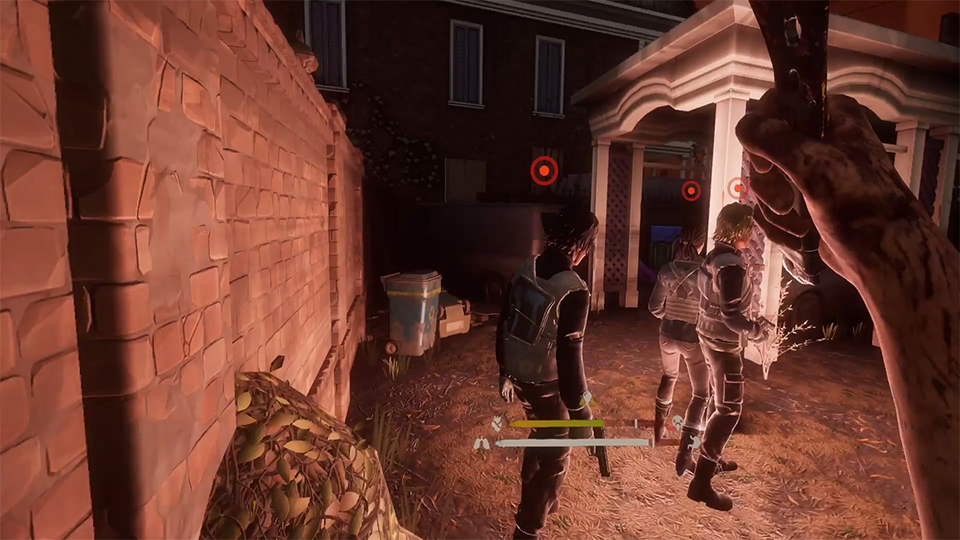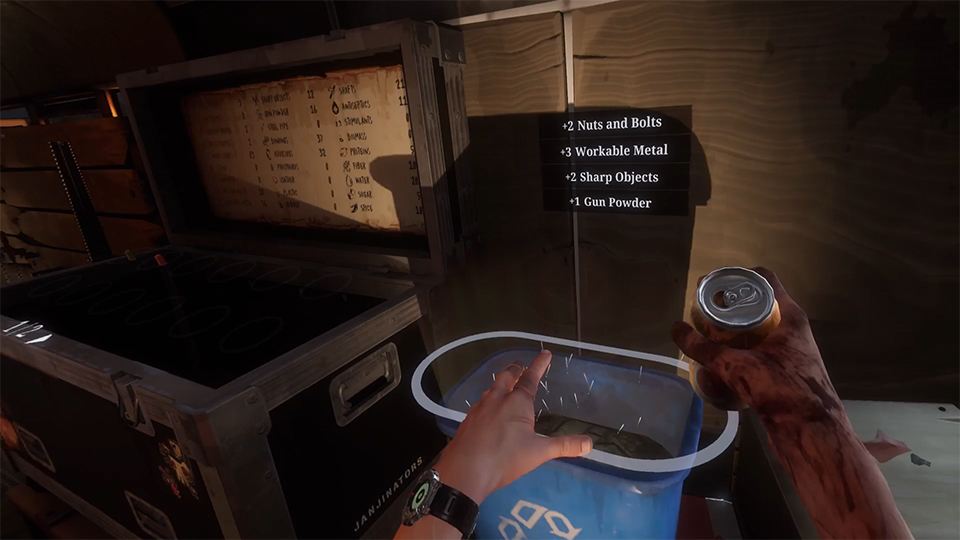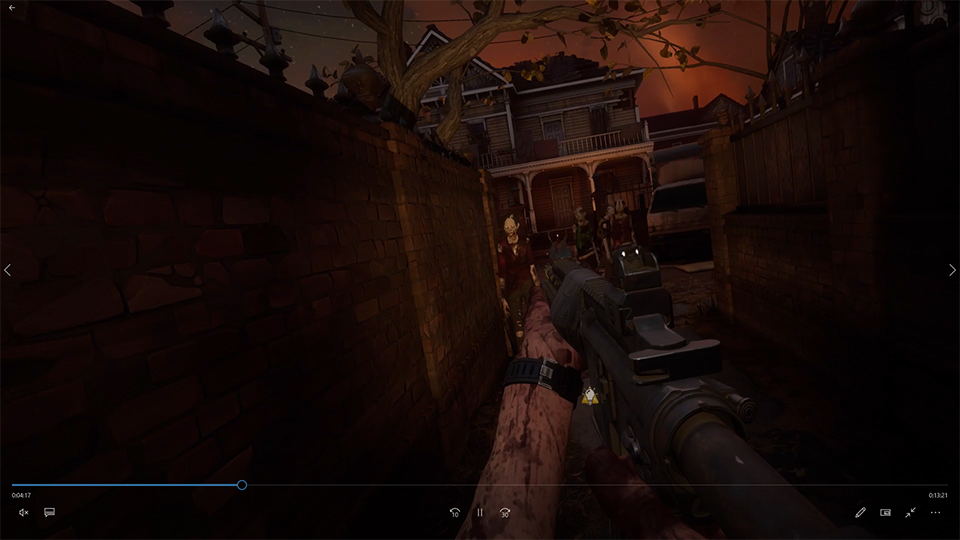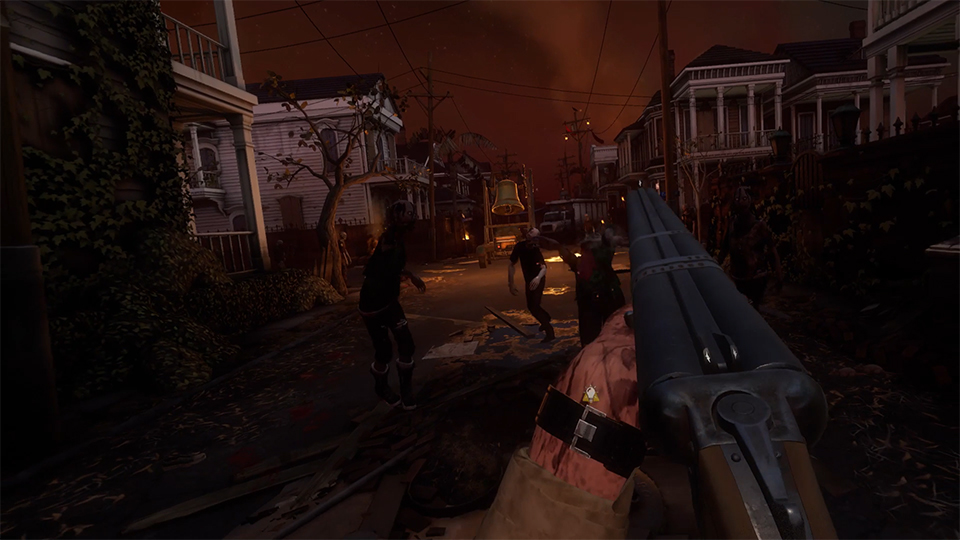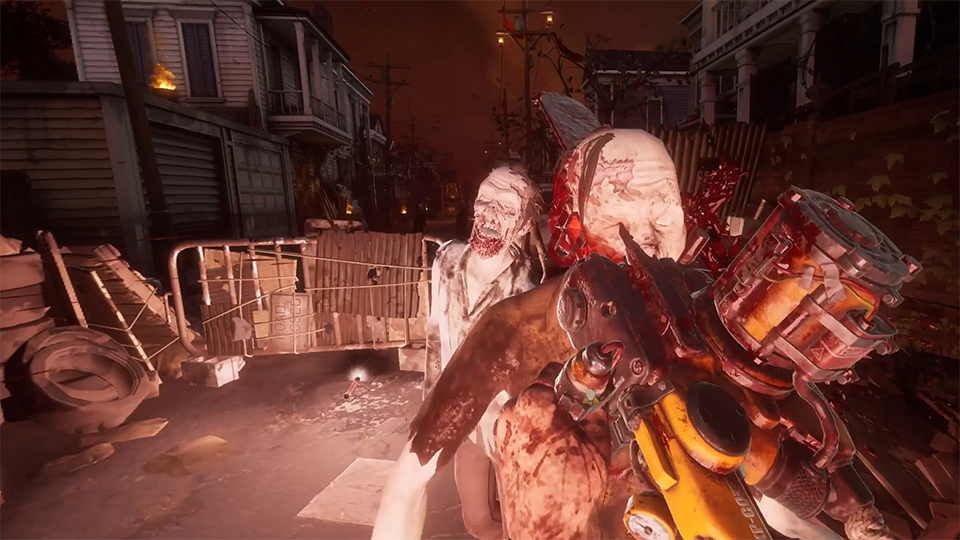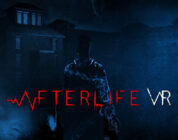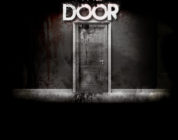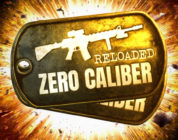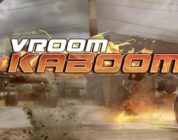Developer / Publisher – Skydance Interactive
Price – US $39.99 / CAN 45.99 / EU €39.99 / UK £29.99
Release Date – December 1st, 2022
Input – 2 x Motion Controllers
Play Area – Seated, Standing
Store Links – Meta
Reviewed on – Quest 2
We’ve already done a review of the Walking Dead Saints and Sinners: Chapter 2: Retribution, but that was for the Quest 2, and we had a lot of issues with it. Now, we have our hands on the PSVR 2 and PCVR versions so stick around and we’ll break them both down for you to see what has changed and which version reigns supreme.
Before we jump into a review of the story, let me just preface this with the fact that Retribution, while a standalone game, really does expect that you have completed the first game. While the game does recap a few of the major events from the last game, this is very much a continuation of the story and the sequel’s narrative and gameplay jumps right off of that. So, spoiler alert.
Upon the fate of the coveted ‘Reserve’ from the first game, you now find yourself hunted by a new, seemingly unstoppable threat: a looming, armored juggernaut that’s out for your blood. Meanwhile, The Tower, New Orlean’s authoritarian power house, has a new scheme to secure utter dominance over the region, and, of course, it has you in its crosshairs. Now, I can’t say that I found the first game’s narrative to be much more than a reason to play the game, and I felt the same here in retribution. Bouncing around New Orleans as everyone’s errand boy remains the same here in the sequel, meeting a host of new key characters that will help to flesh out the game’s narrative. Now, while I don’t feel that story or character development has ever been a strong point of the series, I will say that this time around Skydance Interactive does a much better job of developing real antagonists to our character instead of the way the first game kind of just put us in the way of ongoing events. The Tourist’s actions from the first game have made him some enemies, so it’s nice to see that play out here in the story.
Moving on to gameplay, I’m going to assume that if you’re reading this review, you have played the first Saints and Sinners. If you haven’t, I strongly recommend you go back and watch our complete review for the first game on YouTube, play the first game, and then come back. So, for you Saints and Sinners veterans, gameplay wise- you’re going to feel right at home here. Jumping into Retribution and its 10- to 12-hour campaign feels just like the next day in Saints and Sinners. Now, I don’t mean that as a negative as the first title was polished as hell. To this day, Saints and Sinners is still one of the gold standards for a full locomotion VR action title, but the developers definitely went with the if it ain’t broke mentality with Retribution and played things a bit safe. Starting up a new game, you are given the option of either importing your save from the first game (giving you the benefit of starting with the gear and recipes you attained in the first game) or starting over in Retribution. Starting over in Retribution doesn’t mean you are starting from scratch though, as the streets of New Orleans in Retribution are much more dangerous, with increased zombie numbers and enemy NPC factions. Not to mention the inclusion of night missions…but more on that in a bit. As such, players starting out fresh will see the old crafting tables have been leveled up a bit already. In addition, your armory in the bus is stocked up with some higher end toys and your new base of operations down in the catacombs is filled with junk to recycle. All of this lets you hit the first mission in fighting form, and not swinging spoons and frying pans. Now, I have to say that I was a little torn about starting off so well prepared, as the survival fan in me didn’t really like this. Half the fun for me in survival games is the rags to riches progression. That being said, I also do like kicking ass. Regardless of what side of that you land on, the increased zombie count and faction NPC altercations early on does burn through some of that early buffer you start with.
Those not great at being stealthy (yours truly included) will quickly find themselves back to scavenging in order to survive. The addition of two new crafting tables is where players will find all the new toys and perks added to Retribution, opening a whole new reason to scavenge. New weapons range from an uzi and sawed off shotgun to more heavy weapons like the chainsaw and grenade launcher. In addition, weapons can now be modified with such add-ons as silencers and laser sights. And while most of the toys are on the one crafting table, the second table is devoted more to character buffs such as the much appreciated increased stamina, various combat gloves, as well as further buffs to combat resilience. So, essentially more of what we got in the first game, making you an even bigger badass. Along with this also comes a few new ingredients to keep an eye out for, most notably Phosphorus, an ingredient found predominantly in items scrounged at night and highlighted by the flashlight’s new ultraviolet mode. Phosphorus is the key ingredient for crafting at the two new tables and, as such, night missions become the predominant new feature here in the sequel. It’s essential not just for crafting, but in the game’s mission structure as well, resulting in many night-only missions and an entire side mission hustle based around night raids. These set of side missions introduce a trading network led by a contact known as the Pawn King. Once introduced, a section in your notepad opens up and lists each of the game’s areas and three possible retrieval missions you can take on at night (providing you can find the contact in each map). Traveling at night, whether on a Pawn King side mission or one of the game’s story missions, is definitely where I found that Retribution was at its best, feeling a little more fresh and a little more dangerous than the first game. A higher zombie count and more aggressive zombies are par for the course at night, compounded by of course your reliance on staying in the shadows to remain undetected while simultaneously relying heavily on your flashlight to navigate the dark streets. Consequently, night raids also offer up the chance for better loot coming often in the form of not only the aforementioned phosphorous ingredient, but also higher end weapons and other survivors’ abandoned, lootable backpacks. Now here is where, gameplay-wise, we see the first big change from the Quest 2 version to both the PSVR 2 and PCVR versions: the increase in zombie count, especially during the night raids, is like playing two completely different games. Whereas the Quest 2 version certainly did increase the zombie count, it was often just a minor bump in zombies, seeming to rely on cheap zombie spawns behind you in order to feel more threatening. However, the PSVR 2 and PC versions throw literal hoards at you, making for encounters that, if unprepared for, will turn you into Glen faster than you can say “baseball bat”. And if you are prepared? Let there be carnage! And yes, the PSVR 2 version is pound for pound right up there gameplay wise with the PC version. Back into the daylight and Saints and Sinners Chapter 2 honestly feels more like Chapter 1.5, as, of the twelve areas you visit, only four are new. Old areas like the Shallows, Rampart, Via Corolla, and the Ward all return. While noticeably war torn they are very familiar, giving a sense of nostalgia (or deja vu) while scrounging for mostly the same items you did in the first game.
….and seriously what is with all the bbq lighters in New Orleans?
The new areas are welcomed though and bring with them a bit more complexity and verticality. Most of the new areas bring us into the more urban areas of New Orleans, and eventually to the Tower itself. Thankfully, while Retribution retreads many areas and ideas from the first game, it also ramps up the overall level of combat, making it more necessary than before to show up to areas ready to fight. This is where the new crafting tables and the toys that come with them again help Retribution to feel like something new. The chainsaw as a weapon is a real standout and honestly almost reason enough to play the sequel. It’s all types of brutal fun, and sees Saints and Sinners dip its toe into some of the deeper zombie carnage I wanted from the sequel. Thankfully these more capable versions have also made the chainsaw gameplay much more enjoyable than the Quest version as the chainsaw mutilations just about broke the Quest. Both the PSVR and PC feel much more capable of supporting the game, running smooth as butter.
Unfortunately, the old Saints and Sinners game engine once again being used here seems to only be able to do so much, so don’t expect any leg amputations or entrails spilling out. It’s a disappointment for me, but I might have issues.
As mentioned before, much of what is here in Retribution is more of the same, and while this may not be exciting to hear, it also isn’t a bad thing. Personally, I loved the game loop and the weighty methodical combat of the first game. Thankfully much of the jenkiness that plagued the Quest 2 version at launch is largely absent from the PCVR and PSVR 2 version. The PSVR 2 version is the most polished. With a few small exceptions here and there, the PSVR 2 and PCVR versions play like the polished game we had hoped for back in November with the Quest 2 release. Gone are any issues with invisible zombies and weapons that won’t cut- issues that drove us crazy. Additionally, the A.I., while still not incredible, is no longer competing with the Espire series for dumbest NPC’s in a video game. The Quest version at launch saw human NPC’s staring at walls and even running right past me at times, making the zombies look more intelligent. Thankfully most of that has been done away with, bringing it more in line with the first game at the very least. Finally, something specific to the PSVR 2 version is the inclusion of support for the dual sense motion controllers and headset haptics. Definitely a welcomed inclusion, PSVR 2 owners get to enjoy weighted triggers, an improved tactile sense to handling objects with your hands, and a real wakeup call the first time they take a shot to the head from an NPC or a bite to the face from a zombie. The headset haptics kicks to the skull are very immersive. That being said, it never quite hits the highs of the implementation found in Resident Evil 8: Village, never fully utilizing the HD haptics in the controllers or the head haptics like they could. Speaking of controllers, tracking here is good across the board whether on PC or PSVR, though the usual occlusion issues did crop up from time to time when aiming with a gun or bow with headsets that use inside out tracking like the Quest 2 or PSVR 2. Playing on PC? Mileage may vary here.
Visuals is where things get really interesting. While it’s not entirely fair to compare PCVR and PSVR 2 graphics to those of the Quest 2, it’s important to address that the Quest 2 version was and still is a visual mess. Rife with texture pop in, low resolution textures, and a general lack of polish, the Quest 2 graphics are not what you’ll see on the PCVR and PSVR 2 versions. I had said in my previous review of the Quest 2 version that I thought it was likely pushing the Quest 2 beyond what it could pull off, and now having played the PSVR 2 and PCVR versions, I’m more convinced of that than ever. Honestly, playing such a highly anticipated sequel on the Quest 2 was painful at times, and jumping into these higher end versions of Retribution was like coming home to a best friend.
Enough about the Quest 2 version. Graphically the PCVR and PSVR 2 versions are on a completely different level. They feel like natural progressions from the PCVR version of the first Saints and Sinners, which is sure to be a significant and much appreciated upgrade for those coming from the PSVR 1 version of the first title as their reference point. Now, I say a natural progression from the PCVR version of the first game as Retribution is fundamentally and visually the same game as the first. It retains the same general art style of the first game, which was pulled much more from the comic books or telltale series of games than the TV shows. The big differences here from the first game can be seen in an increased level detail both in texture and in the level design. The former being evidenced in the more interesting world design due to the continued dilapidation and disarray of New Orleans following the first game’s events. Retribution also offers much more exploration of building interiors and definitely makes a concerted effort to make them more interesting and varied to explore. This can also be seen in the game’s level design as well, as Retribution has greatly opened up the verticality of its levels. This is best evidenced in the game’s new locations like the Hotel Éclair, Bourbon Street and, of course, The Tower. The previously mentioned night raids offer additional visual variety as they can start out truly pitch black and will slowly move towards sunrise if you last long enough to see it. Making things even better here is the drastic increase in the brightness of the flashlight, a key complaint I had in the first game, and an improvement that is very welcomed with the focus on night missions. The addition of flares are a cool addition to gameplay that show off the game’s improved lighting effects. Lighting effects happen to be the other big improvement seen in Retribution running on the PSVR 2 and PCVR. Lighting effects have been much improved in the sequel, and can really impact the general feel of the game. Everything from improved reflections, god rays and overall improved texturing benefits from a much more sophisticated use of lighting. As these lighting effects are almost completely absent on the Quest 2 version, it feels lifeless in comparison.
Now here is where things get interesting, and something I have been saying over on The Virtual Boys Podcast, this could be the start of something we will see more of. While the PCVR version looks great, it is actually not the best looking version. Even running a 3080 on my PC, the highly optimized PSVR 2 version is pound for pound my preferred version as jumping back and forth reveals some interesting differences. The PC version, with everything set to Ultra and super sampling set to 150%, looks sharper… at first. Close up, yes, Zombies and weapons look sharper on the PC but further scrutiny reveals that the PSVR 2 version (that, as far as I can tell is not even using dynamic foveated rendering) is actually a sharper image overall when looking out into the game world and all around. This, when combined with the PSVR 2 version running at a flawlessly smooth native FPS in the headset, with zero reprojection, and the PSVR 2 version is a much better experience than the PC version. Which really says something about being able to optimize for a single set of specs. Mura be damned, because the OLED display of the PSVR 2, when compared to the Quest 2’s LCD display running the PCVR version, makes the Quest 2 look absolutely washed out when in the headset.
Now let me be clear, I’m not saying this to fanboy out on the PSVR 2 and, of course, depending on your PC specs and VR headset, mileage may vary, but I’m floored by the work that Skydance has put into the PSVR 2 version. It definitely sets an example to developers looking to make premium VR content and considering the PCVR and PSVR 2 as a combined market to actually make a return on their investment.
On the audio side of things everything seems to be on point here in the sequel, retaining the first game’s level of quality and excellent use of 3D audio. You can also still turn on your microphone so zombies can actually hear you if you squeal in fright. Now, I was a big fan of the first game’s audio design, and enjoyed the nuanced music and loved the weight of combat sounds, both melee and ranged. So more of the same here is good in my books, and shouldn’t be too much of a surprise as most of the effects and music tracks are simply recycled here. New voice actors brought in for new characters retain the quality and tone from the first, and the chainsaw sounds about as gnarly as you would hope.
This brings us to The VR Grid’s final thoughts and review score. The Walking Dead: Saints and Sinners Chapter 2: Retribution, while a standalone title is much less a sequel to the first game than it is a continuation. Jumping into Retribution is VR gaming comfort food to be sure, as it felt like just the next day in New Orleans. I instantly fell right back into that familiar game loop, with enough new recipes, weapons and areas to entice me to head back out into the zombie apocalypse. A new story kept things fresh and the option of night missions along with a stronger focus on combat was also a welcomed change; game difficulty was increased without going too action heavy and changing the tone of the gameplay. While the Quest 2 version was often a chore to play, these premium versions of Retribution certainly breathed life into it and reminded me again why I love these games. The PSVR 2 version is the best version here, but the PCVR version is also very polished. After a rocky launch on the Quest 2, these versions are a return to form for the series.
Skydance Interactive provided The VR Grid with a press code for this title and, regardless of this review, we thank them for that!
